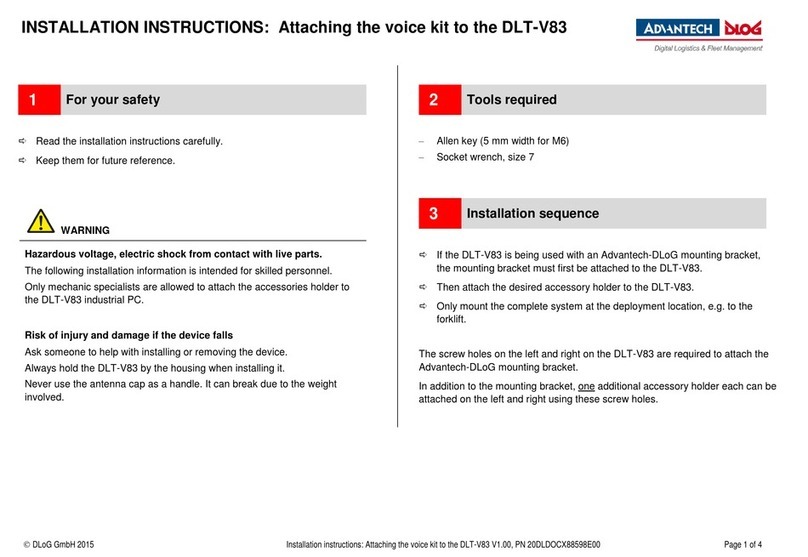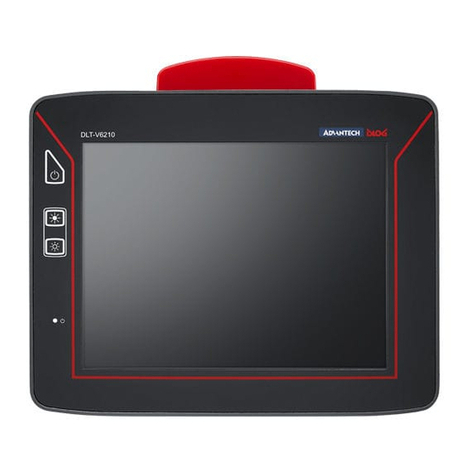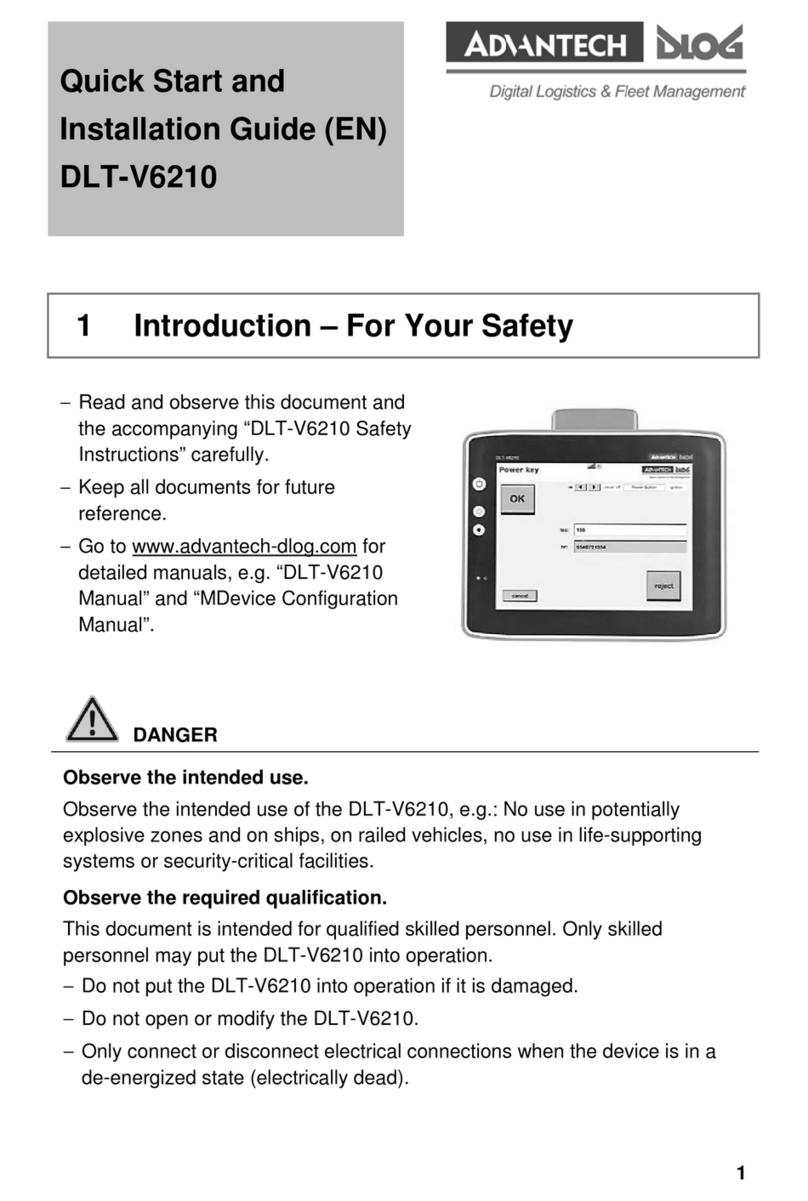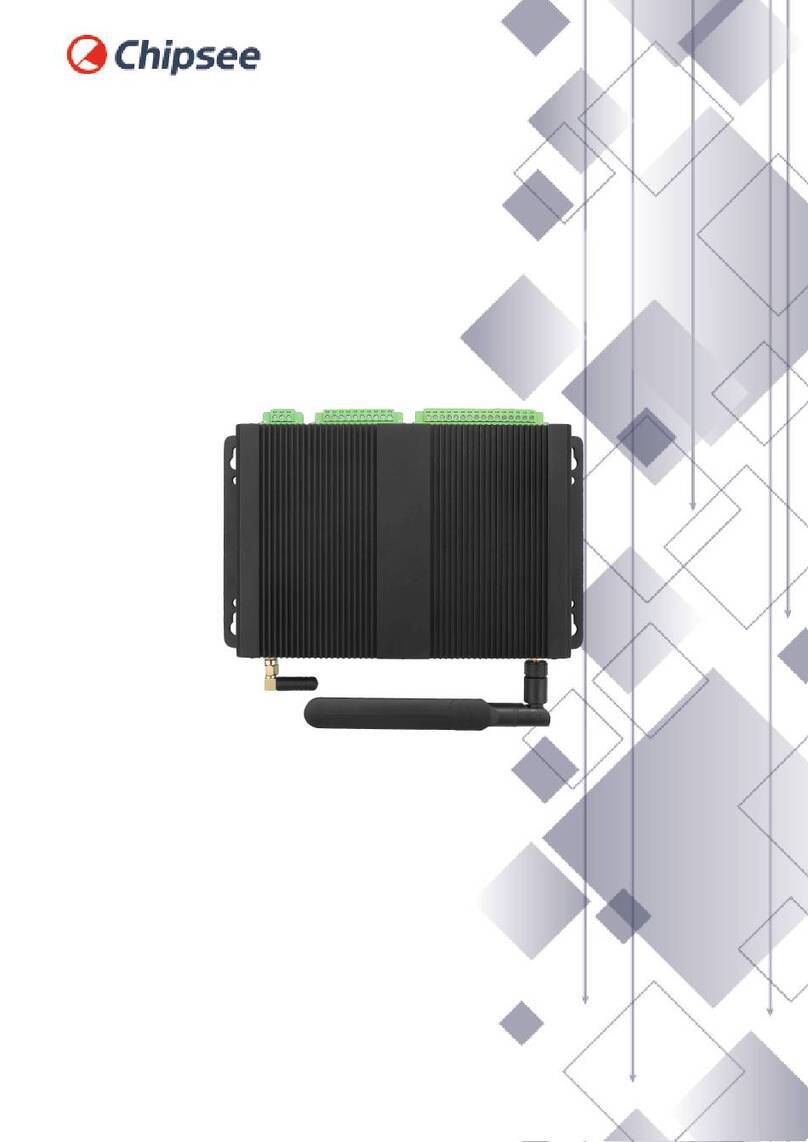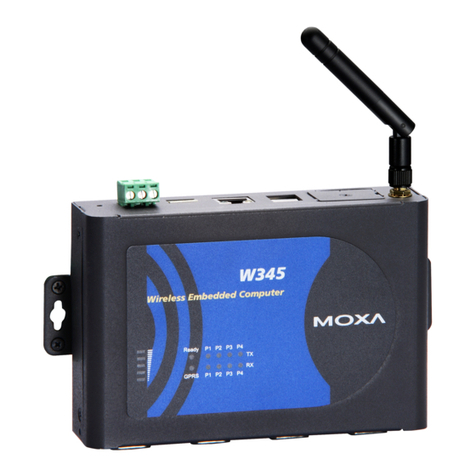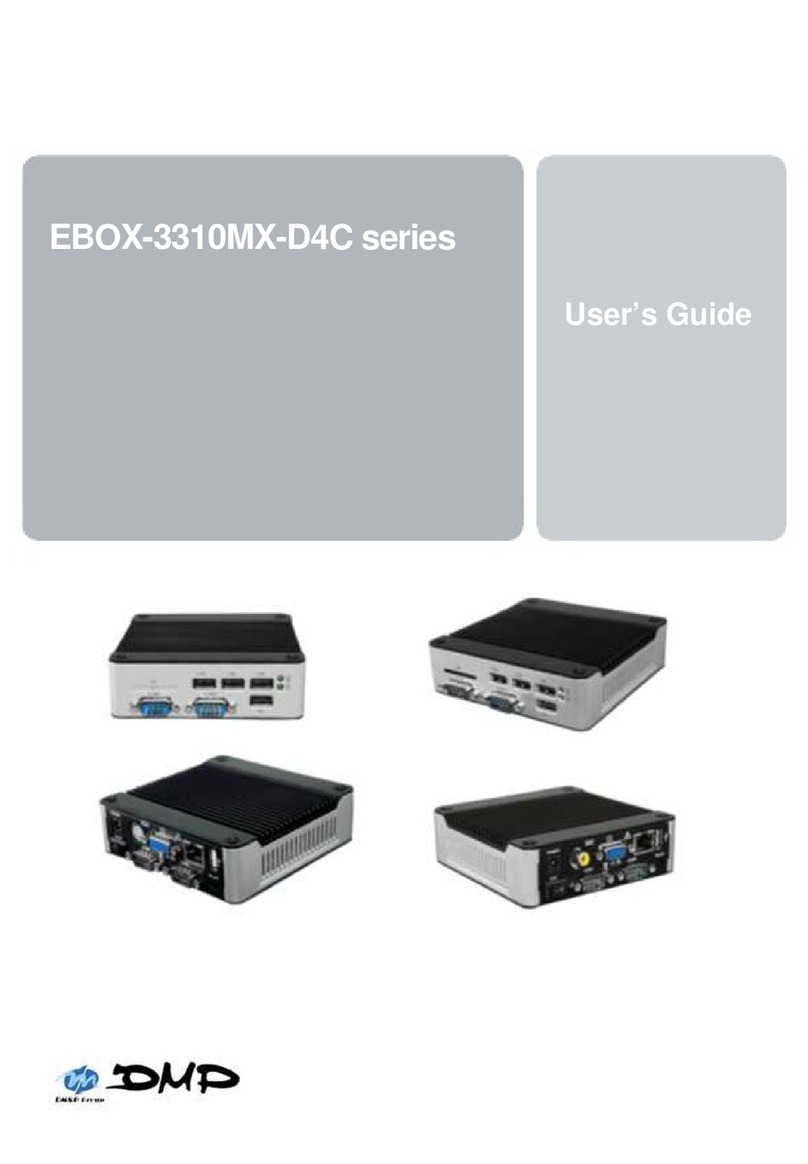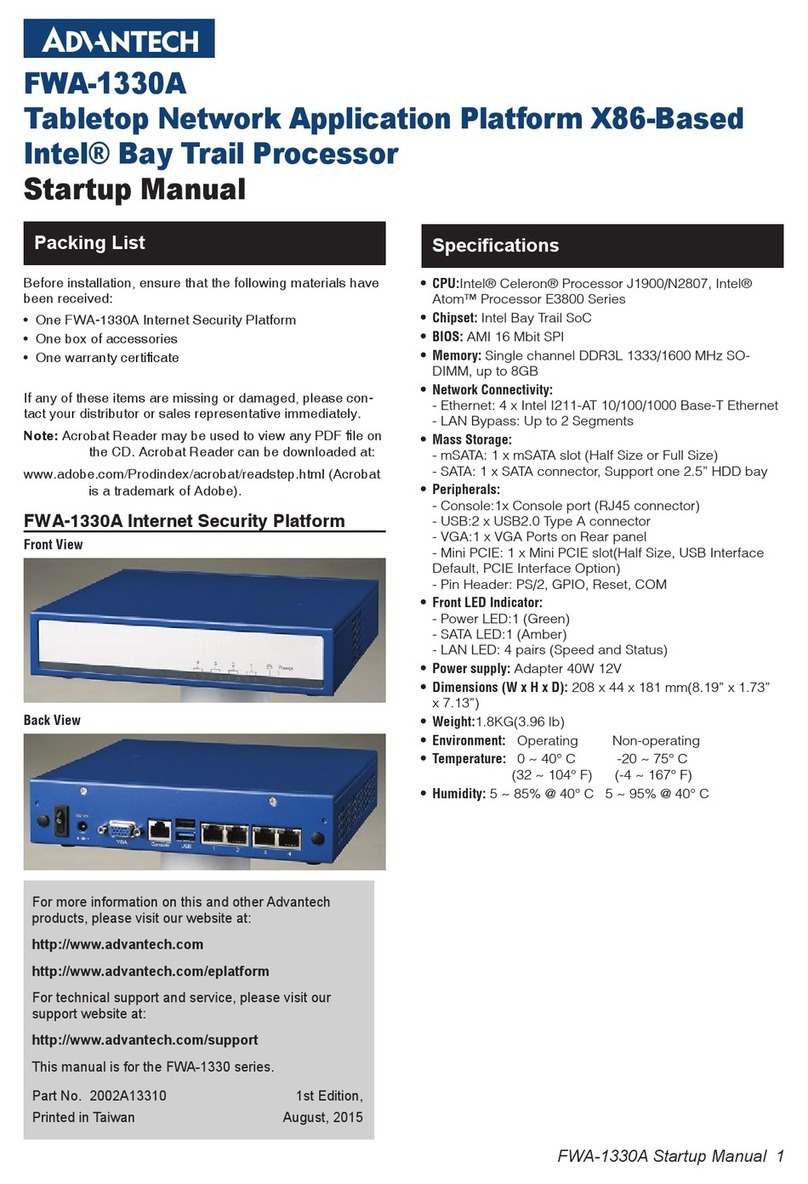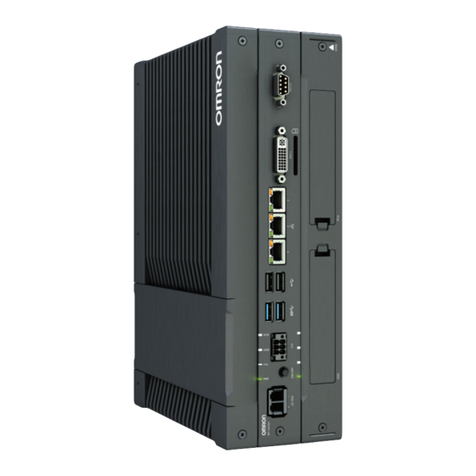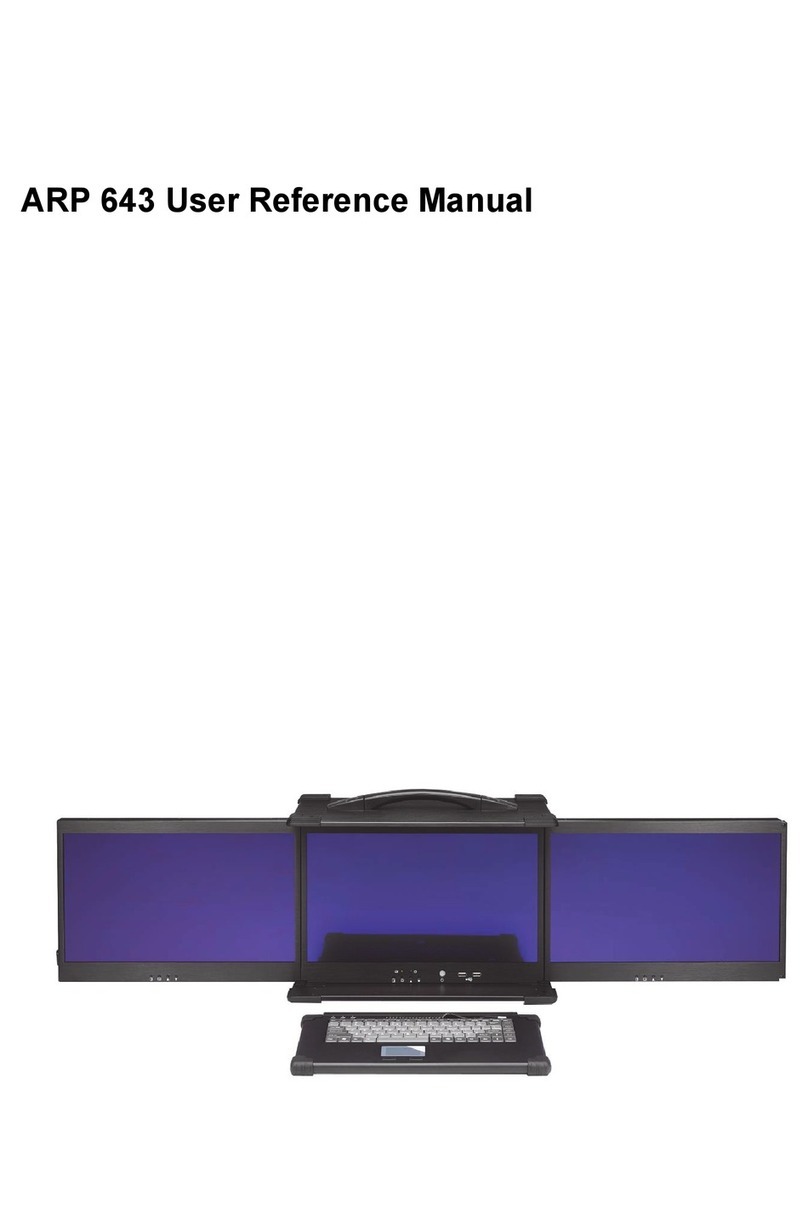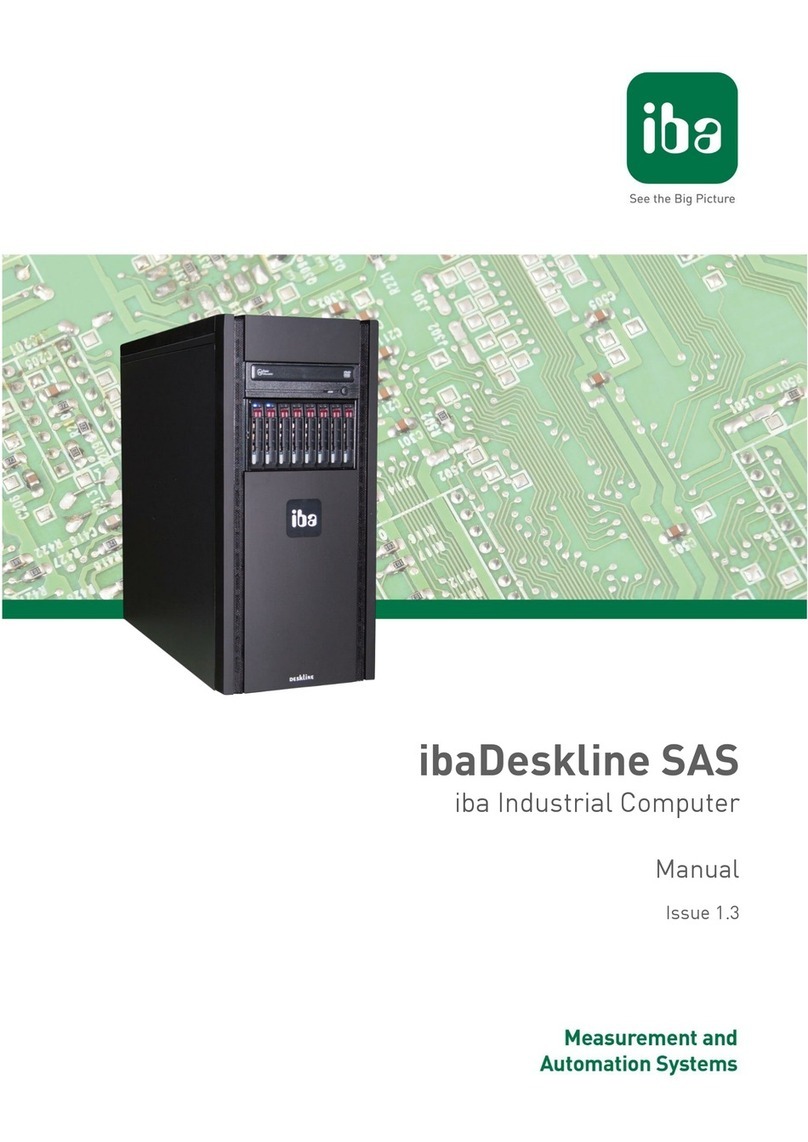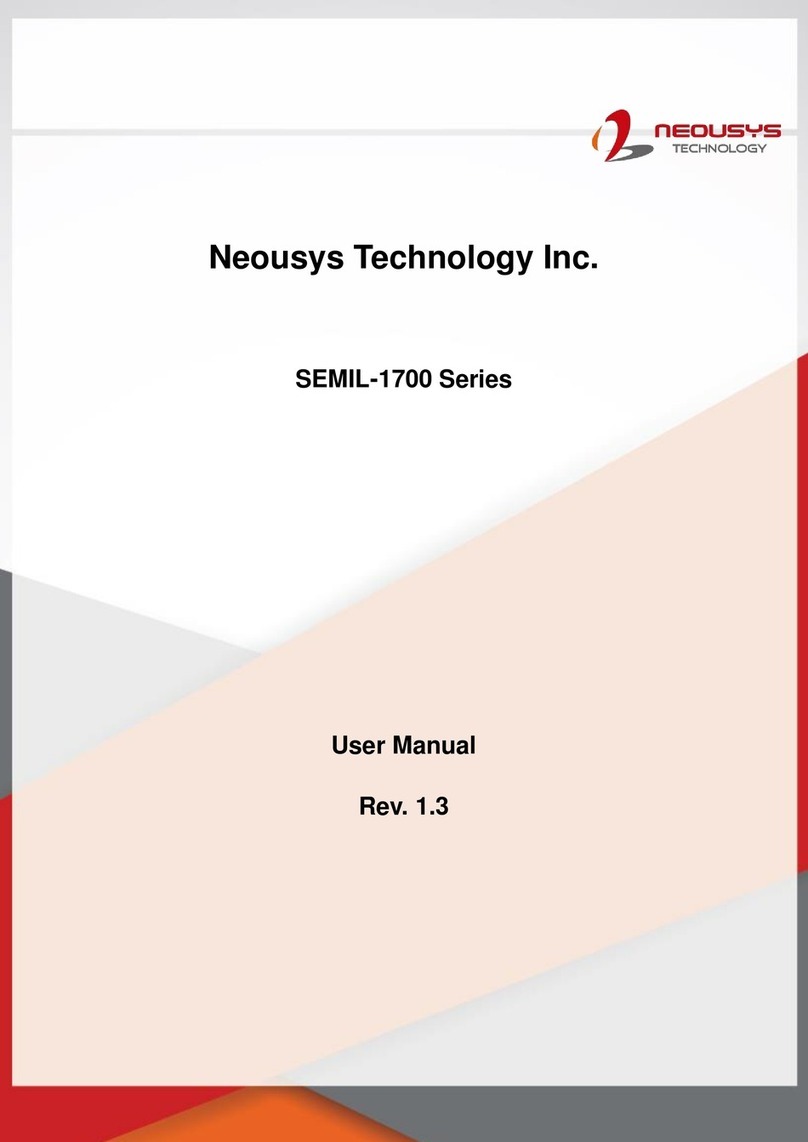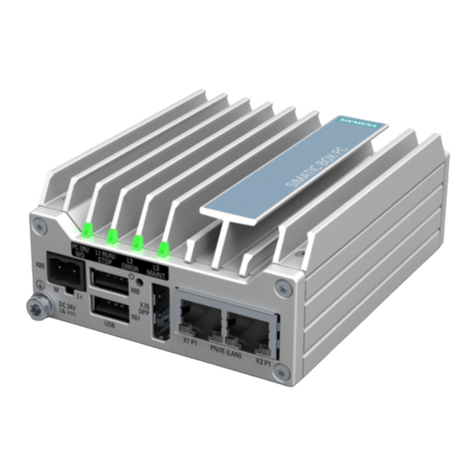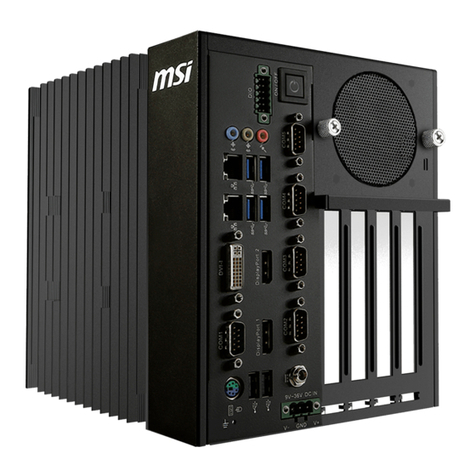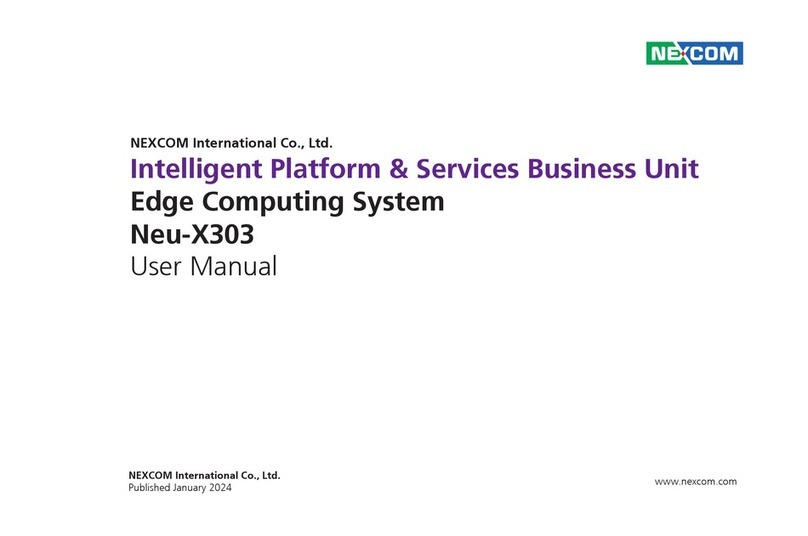Advantech-DLoG DLT-V83 Series User manual

DLT-V83 Series
Industrial Computer
Operating Instructions V2.00 (EN)
Operating Instructions

IMPORTANT:
For safe and proper use, follow these Operating
Instructions.
Keep them for future reference.
Operating Instructions completed on March 5, 2019.
Version 2.00
Copyright
This document and the software and hardware included with this product are copyrighted 2019 by Advantech Co.,
Ltd. All rights are reserved.
This document is intended for reference purposes only. All product specifications are subject to change without
notice.
Advantech Co., Ltd. reserves the right to make improvements in this document in the products described in this
document at any time without notice.
No part of this document may be reproduced in any form or by any means, electronic, photocopying, recording,
translating, transmitting or otherwise, without prior written permission of Advantech Co., Ltd.
Information provided in this document is intended to be accurate and reliable. However, Advantech Co., Ltd.
assumes no responsibility for its use, nor for any infringements of the rights of third parties, which may result from
its use.
Advantech Co., Ltd. assumes no liability for technical inaccuracies, typographic errors or faults in this
documentation. Advantech Co., Ltd. also assumes no liability for damages caused directly or indirectly by the
delivery, performance or usage of this material.
Note regarding all links and website content included in this document:
Advantech Co., Ltd. is not responsible for the accessibility of the websites and for the content of external links
contained in this document. The content and accessibility of the linked websites are the sole responsibility of their
operators.
Acknowledgements
The software and hardware designations as well as the brand names used in this documentation are in most
cases also registered trademarks and are subject to the international law (trademark, brand and patent-protection
laws). All product names or trademarks are properties of their respective owners.
Windows® is a registered trademark of Microsoft Corporation in the United States (US) and other countries.
Intel® and Pentium® are registered trademarks of Intel Corp.
Bluetooth® is a registered trademark of Bluetooth SIG, Inc. (Special Interest Group).
RAM® and RAM Mount™ are both trademarks of National Products Inc., 1205 S. Orr Street, Seattle, WA 98108.
DLT-V83 Industrial Computers can be delivered with or without preinstalled software. For devices with
preinstalled software observe the associated license agreements.
FreeRTOS™ is a registered trademark of Real Time Engineers Ltd (http://www.freertos.org).
This product uses FreeRTOS. FreeRTOS is licensed with a modified GNU GPL
http://www.freertos.org/a00114.html.
The FreeRTOS source text is available from http://sourceforge.net/projects/freertos/files/FreeRTOS/V7.4.0/ or
from Advantech.
Manufacturer
Advantech Co., Ltd.
No. 1, Alley 20, Lane 26, Rueiguang Road, Neihu District, Taipei 11491, Taiwan, R.O.C.

Table of contents
1. INTRODUCTION...........................................................................5
1.1. Information about the DLT-V83 manuals ...............................5
1.1.1. Current manual versions......................................................................5
1.1.2. Operating instructions for alldevice models........................................5
1.1.3. Warningsand notes in the operating instructions...............................6
2. TECHNICAL CUSTOMER SUPPORT.......................................... 7
3. FUNCTIONAL DESCRIPTION...................................................... 8
3.1. Intended use...........................................................................8
3.2. Mount, operate and service the device correctly....................9
3.3. Device identification / name plate...........................................9
4. UNPACKING, TRANSPORTING, STORING DLT-V83................ 10
4.1. Unpacking...............................................................................10
4.2. Transporting............................................................................10
4.3. Storage...................................................................................11
5. TECHNICAL DATA OF THE DEVICE.......................................... 12
5.1. General...................................................................................12
5.1.1. CPU, chipset, RAM, BIOS...................................................................12
5.1.2. Memory................................................................................................13
5.1.3. Housing, material, weight....................................................................13
5.1.4. Display.................................................................................................13
5.1.5. Environmental conditions.....................................................................14
5.1.6. Resistive touchscreen..........................................................................15
5.1.7. Projected-capacitive touchscreen (PCT).............................................16
5.1.8. Device dimensions...............................................................................17
5.1.9. Internal speaker, sound.......................................................................20
5.2. Power supply units, power supply..........................................21
5.2.1. Integrated DC power supply unit.........................................................21
5.2.2. Integrated AC power supply unit.........................................................24
6. TECHNICAL DATA ON RADIO MODULES................................. 27
6.1. Identification of the equipment variants..................................27
6.2. Radio cards.............................................................................27
6.2.1. Available radio cards forWLAN...........................................................27
6.2.2. Available Radio cards for WWAN........................................................29
6.3. Antennas.................................................................................30
6.3.1. WLAN antennadiversity, low profile IEEE802.11 a/b/g/n..................30
6.3.2. WLAN antenna IEEE 802.11 a/b/g/n/ac..............................................31
6.3.3. WLAN, WWAN 3G...............................................................................32
6.3.4. WLAN, WWAN, LTE 4G antenna (Multiband).....................................33
6.3.5. External WLANantenna IEEE 802.11a/b/g/n.....................................34
6.3.6. External WWAN antenna3G...............................................................35
6.3.7. External WWAN antenna2G, 3G, 4G.................................................36
6.4. Bluetooth (optional).................................................................37
6.4.1. Bluetooth integrated: WLAN card SPARKLAN WPEQ-261ACN
(BT) 37
6.4.2. Micro Bluetooth adapter (USB stick) ...................................................37
6.5. GPS receiver external (optional) ............................................38
7. INTERFACES, CONNECTORS.................................................... 39
7.1. Integrated................................................................................39
7.1.1. LCD interface.......................................................................................39
7.1.2. Touch interface....................................................................................39
7.2. External...................................................................................40
7.2.1. Serial interfaces...................................................................................40
7.2.2. USB, Service-USB...............................................................................40
7.2.3. Audio interface forhandset..................................................................40
7.2.4. Network interface.................................................................................40
7.3. Serial interfaces - Functions...................................................41
7.3.1. COM1 as a voltage source (optional)..................................................41
7.3.2. COM2 as EIA-422/485 (optional).........................................................41
7.3.3. Network adapter (10/100/1000)...........................................................41
7.3.4. CAN, digital I/O and secondEthernet interface (optional)...................42
7.3.5. Serial interface barcode scanners.......................................................44
7.3.6. Tips & tricks..........................................................................................44
7.4. Connections under the cable cover........................................45
7.4.1. DC devices: connections, expansion interfaces..................................45
7.4.2. AC devices (DLT-V8315 only): connections, expansion interfaces....46
7.5. Connections underneath the antenna/protective cap............. 47
7.5.1. Information on service USB, CFast and MiniSIM card slot................47
8. OPEN/CLOSE ANTENNA (OR PROTECTIVE CAP)................... 48
8.1. Avoid Property damage..........................................................48
8.1.1. Disconnecting fromthe electric powersource.....................................48
8.1.2. Toolsrequired......................................................................................48
8.2. Open/close protective cap......................................................49
8.3. Open/close antenna................................................................49
8.3.1. WLAN antenna IEEE 802.11 a/b/g/n...................................................49
8.3.2. WLAN antenna IEEE 802.11 a/b/g/n/ac..............................................50
8.3.3. WLAN, WWAN 3G antenna.................................................................51
8.3.4. WLAN, WWAN antenna (multi-band) LTE 4G.....................................52
9. OPERATING THE DEVICE...........................................................54
9.1. Safety notes for normal operation, control.............................. 54
9.2. Switching the DLT-V83 on/off.................................................56
9.3. Operating the touchscreen .....................................................56
9.3.1. Preventdamage to the touchscreen....................................................57
9.3.2. Operating the resistive touchscreen....................................................57
9.3.3. Operating the PCT touchscreen..........................................................57
9.4. DLT-V83 front keys with resistive touchscreen ......................58
9.4.1. Overview of the operating elements on the device front.....................58
9.4.2. Device with 26 front keys.....................................................................59
9.4.3. Device with 5 front keys.......................................................................61
9.4.4. Operating states...................................................................................62
9.5. DLT-V83 front keys with PCT touchscreen............................63
9.5.1. Overview of the operating elements on the front side.........................63
9.5.2. Function of the front keys.....................................................................63
9.5.3. Operating states...................................................................................64
9.6. Software keyboard (optional)..................................................65
10. GENERAL DEVICE CONFIGURATION.......................................66
10.1. Operating systems (optional)..................................................66
10.2. Image compatibility of varying CPUs......................................66
10.3. Linux OS (optional).................................................................66
10.4. MS-Windows OS (optional)....................................................67
10.4.1. Setting up MS-Windows.......................................................................67
10.4.2. USB recovery stick...............................................................................67
10.4.3. WES 7 and Win 7Prof.: USB icon in the taskbar................................67
10.5. Configuring the front keys, automatic shutdown, etc..............68
10.6. Automatic shutdown...............................................................69
10.6.1. Functional description..........................................................................69
10.6.2. Sequence.............................................................................................69
10.7. CAN and digital I/O settings (optional) ...................................70
10.7.1. iManager..............................................................................................71
10.8. Protecting the display from the memory effect.......................72
10.9. (Re)calibrating the touchscreen..............................................72
10.10. ErP settings for AC devices....................................................73
10.10.1. BIOS settings in orderto deactivate WakeOnLAN..............................73
10.10.2. MS-Windows settings for deactivating WakeOnLAN..........................73
10.10.3. Power options ......................................................................................74

11. WLAN CONFIGURATION ............................................................ 75
11.1. Safety notice...........................................................................75
11.2. Differences between MS Windows and Linux........................ 76
11.3. Preparation work at the factory...............................................76
11.4. Customer-specific settings .....................................................77
11.5. Windows Zero Configuration (WZC).......................................77
11.6. Advantech WLAN Client Manager (IGX Tool)........................78
11.6.1. Area of application...............................................................................78
11.6.2. After image reinstallation: Driver installation.......................................78
11.6.3. Requirements.......................................................................................78
11.6.4. Driver installation WinEmbStd7...........................................................79
11.6.5. Driver installation Win7Pro / Win8.1 IndPro / Win 10 IoT...................81
11.6.6. Start WLAN Client Manager, Login.....................................................86
11.6.7. WLAN Client Manager functions.........................................................88
11.6.8. License.................................................................................................88
11.6.9. Browse nearby wirelessnetworks.......................................................89
11.6.10. Roam Management.............................................................................96
11.6.11. Laird Connection Manager (LCM).......................................................101
12. WWAN CONFIGURATION........................................................... 103
12.1. Safety notice...........................................................................103
12.2. Differences between MS Windows and Linux........................ 104
12.3. Preparation work at the factory (DLT-V83 delivery status)..... 104
12.4. SIM card for WWAN (customer-specific)................................ 105
12.5. Configuration of radio card SIERRA WIRELESS MC80 ........105
12.5.1. Open device manager.........................................................................106
12.5.2. Establish Internet connection...............................................................106
12.5.3. SIERRA WIRELESS MC80 Trouble Shooting....................................109
12.6. Configuration of Radio card QUECTEL EC25........................112
12.6.1. Establish Internet connection...............................................................112
12.6.2. QUECTEL EC25 TroubleShooting.....................................................115
13. MECHANICAL MOUNTING.......................................................... 118
13.1. Warning about injuries and Property damage........................ 118
13.1.1. Important: Installation of the DLT-V83on vehicles.............................119
13.2. Overview of mounting steps...................................................120
13.3. Connecting external accessories to the DLT-V83.................. 120
13.4. Attaching device mounting and accessory mounting
(optional)...............................................................................................121
13.4.1. VESA drill holes...................................................................................121
14. ELECTRICAL CONNECTION....................................................... 124
14.1. Connection to the power supply.............................................124
14.2. Connecting DC devices to the power supply.......................... 125
14.2.1. Important: Electrical connection of the DLT-V83 to vehicles...............126
14.2.2. Electrical installation of DC devices.....................................................126
14.2.3. Electrically isolated installation of DC devices....................................127
14.3. Connecting AC devices to the power supply.......................... 128
14.3.1. Electrical installation of AC devices.....................................................128
15. ATTACHING THE CABLE COVER.............................................. 129
15.1. Overview of mounting steps...................................................129
15.2. Required components ............................................................130
15.3. Attaching cable grommets and fixing strain relief in place..... 131
15.3.1. Attaching the cable cover (withoutintegrated UPS)............................134
15.3.2. Attaching the cable cover (with integrated UPS).................................134
15.4.Pressure compensation element............................................135
16. OPTIONAL EQUIPMENT/ACCESSORIES..................................136
16.1. Integrated UPS (optional).......................................................136
16.1.1. UPS Batterypack specification............................................................137
16.1.2. Charging the integrated UPS correctly................................................138
16.1.3. No repair/replacement of the battery packs.........................................138
16.2. Screen-Defroster (optional)....................................................138
16.3. Pre-converter and power cables (optional).............................139
16.4. Voice Kit (optional)..................................................................139
16.5. Terminal mountings (optional)................................................140
16.6. Keyboards and keyboard holders (optional)...........................140
16.7. Stylus for touchscreens (optional)..........................................141
16.8. External CD/DVD-ROM drive (optional)................................. 141
16.9. USB recovery stick (optional).................................................142
16.10. Scanner and scanner bracket (optional).................................142
16.11. Sun visor (optional).................................................................142
16.12. Protective film for touchscreen (optional)...............................142
17. MAINTENANCE, CLEANING....................................................... 143
17.1. Manufacturer, authorized service centers ..............................143
17.2. No repair/replacement of the battery packs............................143
17.3. Regular checks and maintenance of the complete system....143
17.4. Cleaning the device................................................................144
17.4.1. Cleaning the housing...........................................................................144
17.4.2. Cleaning the touchscreen....................................................................144
17.5. Touchscreen protective film (optional)....................................145
18. MALFUNCTIONS..........................................................................146
19. REASONABLY FORESEEABLE MISUSE...................................148
19.1. General...................................................................................148
19.2. Mobile application on vehicles................................................148
19.3. Stationary use with AC power supply unit..............................148
20. GUIDELINES AND CERTIFICATES............................................. 149
20.1. Simplified EU declaration of conformity.................................. 149
20.2. Low-voltage guidelines...........................................................149
20.3. EMC guidelines.......................................................................149
20.3.1. Shielded components..........................................................................149
20.3.2. EMC EU...............................................................................................149
20.3.3.FCC USA.............................................................................................149
20.3.4. ICESCanada.......................................................................................150
20.4. RoHS Directive EU.................................................................150
20.5. RED (Radio Equipment Directive) 2014/53/EU......................151
20.6. Eco-design directive (2009/125/EC).......................................152
20.7. CE marking.............................................................................152
20.8. CCC, SRRC China .................................................................152
20.9. CNROHS................................................................................153
20.10. MIC Japan (previously TELEC)..............................................153
21. RECYCLING INFORMATION.......................................................154
22. LIST OF FIGURES........................................................................155

Introduction
DLT-V83 Operating Instructions V2.00 5 / 157
1. Introduction
1.1. Information about the DLT-V83 manuals
Available manuals (in printed form or on the Internet, download areas):
Contents For target
group Availability
Safety instructions Important information
about protecting
personnel and property
Skilled
personnel Printed, enclosed with the
device
Quick Start and
Installation Guide First steps in
commissioning,
mechanical and electrical
installation and mounting
Skilled
personnel Printed, included with the
device
Operating
instructions Complete operating
instructions Skilled
personnel PDF file at our websites
DLoG Config,
Software
Keyboard,
Description of software
tools for the
DLT-V83 series
Skilled
personnel PDF file at our websites
Mounting
instructions for
optional
accessories
Information about
mounting Skilled
personnel Printed, enclosed with the
respective accessories
Pay attention to these instructions because they help avoid hazards, reduce repair costs and
downtimes, and increase the reliability and service life of the DLT-V83.
Keep the instructions for future use.
Please contact Advantech if you require additional information or clarification. You can find the
contact address in section Technical customer support.
1.1.1. Current manual versions
The latest versions of our manuals are available at our websites:
www.advantech.com
www.advantech-service-iot.eu
1.1.2. Operating instructions for all device models
These operating instructions apply to all models of the DLT-V83 series. Differences with regard to
operation, functionality, etc. are clearly indicated.

Introduction
6 / 157 DLT-V83 Operating Instructions V2.00
1.1.3. Warnings and notes in the operating instructions
Personal injury
Information with regard to personal injury is shown as follows (signal words for indicating risk level):
DANGER / WARNING / CAUTION
DANGER means that death or severe bodily injury will occur if this information is not observed.
WARNING means that death or severe bodily injury can occur if this information is not
observed.
CAUTION means that slight bodily injury can occur if this information is not observed.
Property damage
Information about Property damage is shown as follows:
NOTICE: Property damage
Information about possible Property damage.
Tips for handling product and operating instructions
Tips for handling product and operating instructions are shown as follows:
TIP
Tips for using the product.
Note about additional information in operating instructions.

Technical customer support
DLT-V83 Operating Instructions V2.00 7 / 157
2. Technical customer support
Contact your distributor, sales representative, or an Advantech Service Center for technical support.
Please have the following information ready:
−Product name
−Serial number
−Description of your peripheral attachments
−Description of your software (operating system, application software, etc.)
−The exact wording of any error messages
−A complete description of the problem
Find the contact data of our Global Advantech Service Centers on website:
http://erma.advantech.com

Functional description
8 / 157 DLT-V83 Operating Instructions V2.00
3. Functional description
3.1. Intended use
DLT-V83 Industrial Computers are data
communication terminals for use in
commercial environments (e.g. logistics,
warehousing, manufacturing). Any other
or additional use beyond this shall be
deemed an improper use. The
user/operator of the DLT-V83 is solely
responsible for any resulting damage.
This also applies to any unauthorized
modifications made to the device.
Indented use includes the compliance
with all safety instructions and the
compliance with the approved
environmental conditions and
specifications for the device.
The DLT-V83 Industrial Computers:
−are not approved for use in EX zones (potential explosion hazard).
−are not approved for use on ships.
−are not approved for use on railed vehicles.
−are not approved for use in life-support systems or critical safety systems where system malfunction
can lead to the direct or indirect endangerment of human life.
Accessories
Only use accessories that have been tested and approved for the respective DLT-V83. Otherwise, any
warranty for this device will be void.
Requirements for safe operation
The requirements are:
−Proper transport and storage.
−Proper setup and use.
−Proper maintenance and service.
−Operation by trained personnel.

Functional description
DLT-V83 Operating Instructions V2.00 9 / 157
3.2. Mount, operate and service the device correctly
DLT-V83 Industrial Computers were designed and built according to modern technology and accepted
safety regulations.
However, the operation of the DLT-V83 can endanger personnel or third parties and cause damage to
the device and other material assets when, for example, the device is:
−installed incorrectly or configured improperly.
−operated by untrained or uninstructed personnel.
−improperly operated and maintained.
−not used as intended.
The owner/operator commitments with regards to safety (accident prevention regulations, occupational
safety) are to be followed.
3.3. Device identification / name plate
The name plate on the rear side of the DLT-V83 must be legible at all times.
Do not damage the name plate or remove it from the device.
Information on the labels on the device (examples):
−Model name, e.g. DLT-V8310, DLT-V8312, DLT-V8315
−Serial number
−FCC ID (Radio)
−Barcode for internal use only

Unpacking, transporting, storing DLT-V83
10 / 157 DLT-V83 Operating Instructions V2.00
4. Unpacking, transporting, storing DLT-V83
4.1. Unpacking
Open the packaging carefully.
Save the packaging material (for possible forwarding transports or returns of the DLT-V83).
Check the shipment for completeness and any possible damage.
Always keep the supplied operating instructions and documents.
4.2. Transporting
WARNING
Personal injury from battery packs: Short-circuit, fire, chemical burns, toxic substances.
Devices with integrated UPS (optional) contain lithium-ion battery packs (hereinafter referred to
as: battery packs). These can ignite if handled improperly (risk of fire), cause chemical burns or
release toxic substances.
Be careful when handling battery packs.
Do not drop or damage battery packs.
Do not allow water or other liquids to come into contact with the device (exercise particular
caution with corrosive liquids).
Risk of injury due to the weight of the device.
The DLT-V83 can fall down and cause injuries due to its weight.
Always hold the DLT-V83 by the housing with both hands.
Never use the antenna cap as a handle. It can break due to the weight involved.
Use the assistance of a second person for installation work.
Risk of injury due to sharp-edged parts on the device.
The strain relief rail of the DLT-V83 can have sharp edges and cause cutting injuries.
Do not hold the DLT-V83 by the strain relief rail.
If a return/repacking is necessary
If the DLT-V83 is being returned to the manufacturer, a completely filled-out return shipment
form must be enclosed with every DLT-V83.
You can find the return shipment form at the end of this operating instructions and on our
websites.
Repackage the device using suitable packaging material to ensure that the device is not
damaged during transport.
For devices with integrated UPS/battery packs, comply with the transport conditions for
battery packs.
Use the required package labels and accompanying documents.

Unpacking, transporting, storing DLT-V83
DLT-V83 Operating Instructions V2.00 11 / 157
4.3. Storage
WARNING
Personal injury from battery packs: Short-circuit, fire, chemical burns, toxic substances.
Devices with integrated UPS/battery packs can ignite if stored improperly (risk of fire), cause
chemical burns or release toxic substances.
Store the cable cover with battery packs separately from the DLT-V83 device.
Handle the cable cover with battery packs carefully; do not damage; do not drill through
and do not crush or drop.
Store segregated, separate from acids and other materials.
Store in a cool, dry place.
Comply with the specified environmental conditions for storage.
Provide for sufficient ventilation of the storage location.
Do not allow water or other liquids to come into contact with the device (exercise particular
caution with corrosive liquids).
Do not store the device near sources of heat or fire, open flames or heaters.
Do not allow it to come into contact with fire.
Have suitable fire extinguishers ready (foam or powder) in accordance with safety
regulations.
Prevent Property damage due to deep discharge
Storing the battery packs incorrectly will cause them to discharge completely (deep discharge) and thus
damage them irreparably.
Place the DLT-V83 into operation within 3 (three) months after receiving it.
Charge the integrated battery packs by connecting the DLT-V83 to the power supply.
If you are not placing the DLT-V83 into operation within 6 (six) months, make sure you charge it
intermediately.
Protecting touchscreens from damage
Protect touchscreens from sharp edges, impacts, and heavy objects.
If stacking, do not stack higher than four devices.
Place devices front-to-front in this case. The VESA mounting point on the rear side of the device
can damage the touchscreen of another device.
Use protective material (non-flammable!) between the devices as a precaution.

Technical data of the device
12 / 157 DLT-V83 Operating Instructions V2.00
5. Technical data of the device
5.1. General
5.1.1. CPU, chipset, RAM, BIOS
Intel® Atom™ D525 processor 1.80 GHz (dual core)
CPU
Chipset
Cache
Intel
®
Atom™ D525 processor
1.80 GHz (dual core)
800 MHz Front Side Bus (FSB) and 800 MHz memory bus speed,
1 MB L2 cache, 45 nm
System chipset Intel®ICH8M
RAM Up to 4 GB
DDR3 technology
BIOS AMIBIOS8®- Flash BIOS with ACPI, PnP
Programmable in the system, BIOS POST self-test
Real-time clock Real-time clock with a power reserve of up to 5 years
Intel® Core™ i5-4300U processor (4th Generation Intel® Core™ i5)
CPU
Chipset
Cache
Intel
®
Core™ i5-4300U (4th Generation Intel
®
Core™ i5)
1.90 GHz (dual core)
Max. 2.9 GHz turbo clock rate
DDR3L 1600
Intel®Smart Cache 3 MB, 22 nm
RAM Up to 16 GB
DDR3L technology
BIOS AMI UEFI BIOS @ 128 Mb
Programmable in the system, BIOS POST self-test
Real-time clock Real-time clock with a power reserve of up to 5 years
Intel®Celeron® 2980U processor
CPU
Chipset
Cache
Intel
®
Celeron
®
2980U
1.60 GHz (dual core)
DDR3L 1600
Intel® Smart Cache 2 MB, 22 nm
RAM Up to 8 GB
DDR3L technology
BIOS AMI UEFI BIOS @ 128 Mb
Programmable in the system, BIOS POST self-test
Real-time clock Real-time clock with a power reserve of up to 5 years

Technical data of the device
DLT-V83 Operating Instructions V2.00 13 / 157
5.1.2. Memory
CFast SLC technology Optional, based on SLC technology (single level cell)
CFast MLC technology Optional, based on MLC technology (multi-level cell)
SSD 2,5“ Optional, based on MLC technology (multi-level cell)
5.1.3. Housing, material, weight
Material Rugged aluminum-cast housing
ESD safe
Weight DLT-V8310: 4 kg
DLT-V8312: 5.5 kg
DLT-V8315: 6.4 kg
Dimensions See Chapter 5.1.8 Device dimension
5.1.4. Display
DLT-V8310 10.4“ SVGA 800 x 600, 400 cd/m
2
Brightness control
Or:
10,4“ XGA 1024 x 768, 400 cd/m²
Brightness control
DLT-V8312 12.1" XGA 1024 x 768, 500 cd/m2
Brightness control
DLT-V8315 15" XGA 1024 x 768, 400 cd/m
2
Brightness control
The LCD display of the DLT-V83 series fulfills the highest quality standards and was inspected for pixel
defects. However, due to technological reasons pixel defects can occur.
This is not a malfunction; it is a part of the technical specifications.

Technical data of the device
14 / 157 DLT-V83 Operating Instructions V2.00
5.1.5. Environmental conditions
DLT-V83 without integrated UPS
Operating temperature -30 to +50 °C
Specification according to EN 60068-2-1/2
Storage temperature -30 to +65 °C
Specification according to EN 60068-2-1/2
Relative humidity 10% to 90% at 40 °C relative humidity, noncondensing
Specification according to EN 60068-2-3
Mechanical vibration
and shock resistance DLT-V8310 and DLT-V8312:
−Class 5M3 according to EN 60721-3-5
−US Highway Truck according to MIL-STD 810F
DLT-V8315:
−Class 5M2 according to EN 60721-3-5
−US Highway Truck according to MIL-STD 810F
DLT-V83 with integrated UPS (optional)
Operating temperature -10 to +50 °C
Charging temperature 0 to +45 °C (internal device temperature)
Storage temperature -20 to +60 °C; specification according to EN 60068-2-1/2
Relative humidity 10% to 90% at 40 °C relative humidity, noncondensing;
specification according to EN 60068-2-3
Mechanical vibration
and shock resistance DLT-V8310 and DLT-V8312:
−Class 5M3 according to EN 60721-3-5
−US Highway Truck according to MIL-STD 810F
DLT-V8315:
−Class 5M2 according to EN 60721-3-5,
−US Highway Truck according to MIL-STD 810F

Technical data of the device
DLT-V83 Operating Instructions V2.00 15 / 157
5.1.6. Resistive touchscreen
Standard version
DLT-V8310
Type 4-wire analog resistive touchscreen
Construction Device without Screen-Defroster: Film-Film-Glass (FFG), fully laminated
front.
Device with Screen-Defroster: Buffer-film-film-glass heater
Resistance Chemically hardened glass
Hardness of
surface JIS-K-5400: 3 H at 750 g
Shock resistance IK08 according to IEC 62262
Mechanical
resistance Tapping: > 1 million times with rubber test pen
Swiping: > 100,000 times with polydactyl pen
Resistance to
industrial
chemicals
Alcohols, dilute acids, dilute alkalis, esters, hydrocarbons, ketones,
household cleaning agents (according to DIN 42 115)
DLT-V8312 and DLT-V8315
Type 8-wire analog resistive touchscreen
Construction Device without Screen-Defroster: Film-Film-Glass (FFG), fully laminated
front.
Device with Screen-Defroster: Buffer-film-film-glass heater
Resistance Chemically hardened glass
Hardness of
surface JIS-K-5400: 3 H at 750 g
Shock resistance IK08 according to IEC 62262
Mechanical
resistance Tapping: > 5 million times with rubber test pen
Swiping: > 100,000 times with polydactyl pen
Resistance to
industrial
chemicals
Alcohols, dilute acids, dilute alkalis, esters, hydrocarbons, ketones,
household cleaning agents (according to DIN 42 115)

Technical data of the device
16 / 157 DLT-V83 Operating Instructions V2.00
Sunlight readable touchscreen version (optional)
Sunlight readable touchscreen
Type 5-wire analog resistive touchscreen
Construction Film-Glass (FG), chemically toughened glass
Hardness of surface JIS-K-5400: 1 H at 750 g
Shock resistance IK08 according to IEC 62262
Mechanical resistance Tapping: > 10 million times with rubber test pen
Swiping: > 100,000 times with polydactyl pen
Chemical resistance to
industrial chemicals Hydrogen peroxide, iso alcohol 50 5, iso alcohol 70%, mineral
spirits, gasoline, motor oil, diesel fuel, transmission fluid, brake
fluid, antifreeze, hydraulic oil, bleach, ethanol, turpentine, acetone,
“diethylene glycol monoethyl ether acetate“, toluene, petroleum
ether, hydrochloric acid, glycol ether acetate, MEK, heptane,
sodium hydroxide
5.1.7. Projected-capacitive touchscreen (PCT)
Some DLT-V83 device models are available optionally with a PCT, for example:
−DLT-V8310 XGA with 9 front keys
−DLT-V8310 SVGA with 9 front keys
−DLT-V8312 with 9 front keys
−DLT-V8315 with 9 front keys
PCT touchscreen
Type Projected-capacitive touchscreen
Construction Glass film
Hardness of surface Hardness JIS-K-5400: > 10 H at 750 g
Shock resistance IK08 according to IEC 62262
Chemical AR coated glass with gloss value 60 according to
ISO 2813, 7668; ASTM D 523, D 2457; DIN 67539
Mechanical properties Thermally pre-stressed, acid-etched planibel float glass
Chemical resistance Resistant to chemicals.
Not resistant to strong acids, gasoline and diesel.

Technical data of the device
DLT-V83 Operating Instructions V2.00 17 / 157
5.1.8. Device dimensions
DLT-V8310
Dimensions without add-ons (in mm)
Fig. 5.1: Dimensions DLT-V8310
The building depth of the DLT-V8310 varies depending on the type of touchscreen:
Device type Building depth
(Mass X, see figure)
DLT-V8310 standard resistive touchscreen 90,0 mm
DLT-V8310 sunlight readable resistive touchscreen 90,0 mm
DLT-V8310 PCT touchscreen 91,5 mm
DLT-V8310 with screen-defroster front 90,7 mm

Technical data of the device
18 / 157 DLT-V83 Operating Instructions V2.00
DLT-V8312
Dimensions without add-ons (in mm)
Fig. 5.2: Dimensions DLT-V8312
The building depth of the DLT-V8312 varies depending on the type of touchscreen:
Device type Building depth
(Mass X, see figure)
DLT-V8312 standard resistive touchscreen 93,0 mm
DLT-V8312 sunlight readable resistive touchscreen 94,7 mm
DLT-V8312 PCT touchscreen 96,0 mm
DLT-V8312 with screen-defroster front 94,2 mm

Technical data of the device
DLT-V83 Operating Instructions V2.00 19 / 157
DLT-V8315
Dimensions without add-ons (in mm)
Fig. 5.3: Dimensions DLT-V8315
The building depth of the DLT-V8315 varies depending on the type of touchscreen:
Device type Building depth
(Mass X, see figure)
DLT-V8315 standard resistive touchscreen 98 mm
DLT-V8315 PCT touchscreen 97 mm

Technical data of the device
20 / 157 DLT-V83 Operating Instructions V2.00
5.1.9. Internal speaker, sound
The DLT-V83 is equipped with an internal speaker as standard (2 W).
The system messages from the Industrial Computer are output via this speaker.
The internal speaker is configured in the audio settings for the operating system in question.
Fig. 5.4: Internal speaker position
Other manuals for DLT-V83 Series
1
This manual suits for next models
3
Table of contents
Other Advantech-DLoG Industrial PC manuals
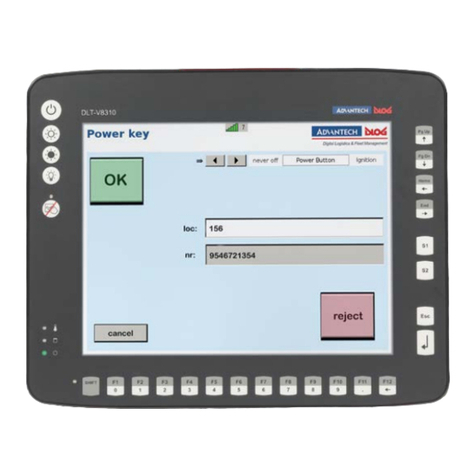
Advantech-DLoG
Advantech-DLoG DLT-V8310 User manual
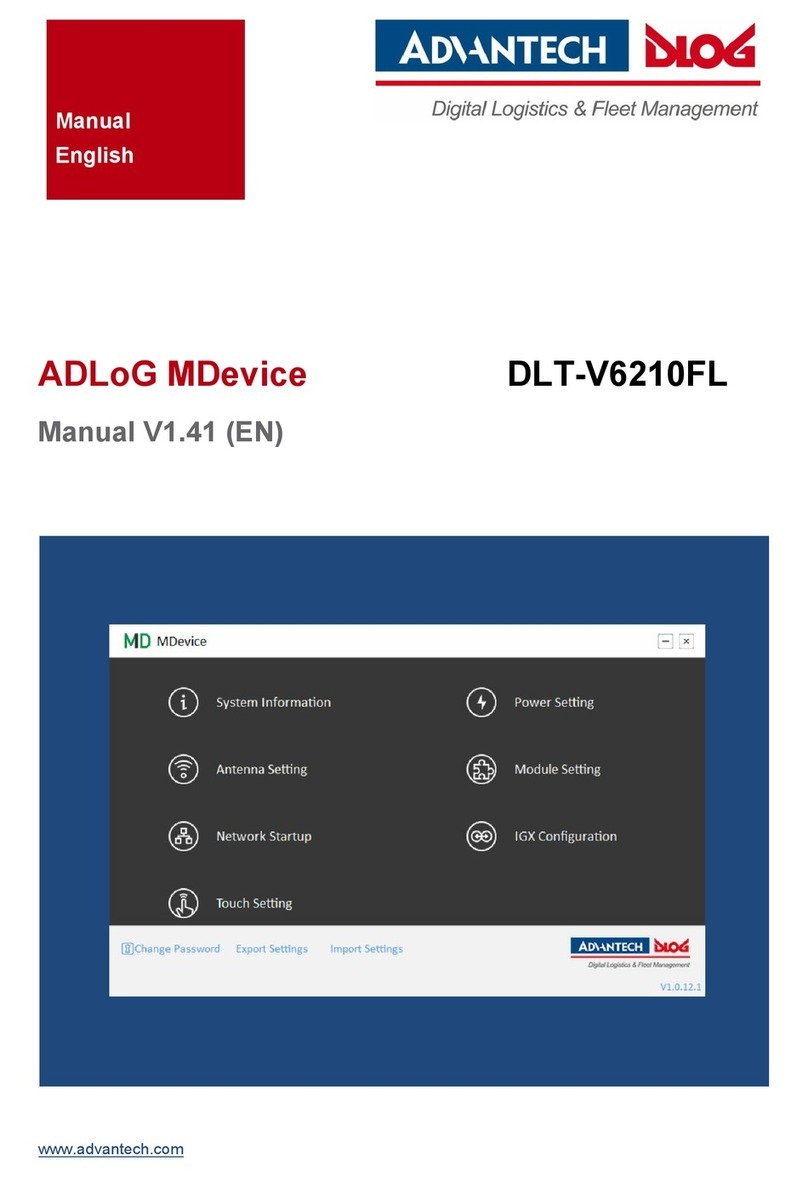
Advantech-DLoG
Advantech-DLoG DLT-V6210FL User manual

Advantech-DLoG
Advantech-DLoG DLT-V4108 User manual
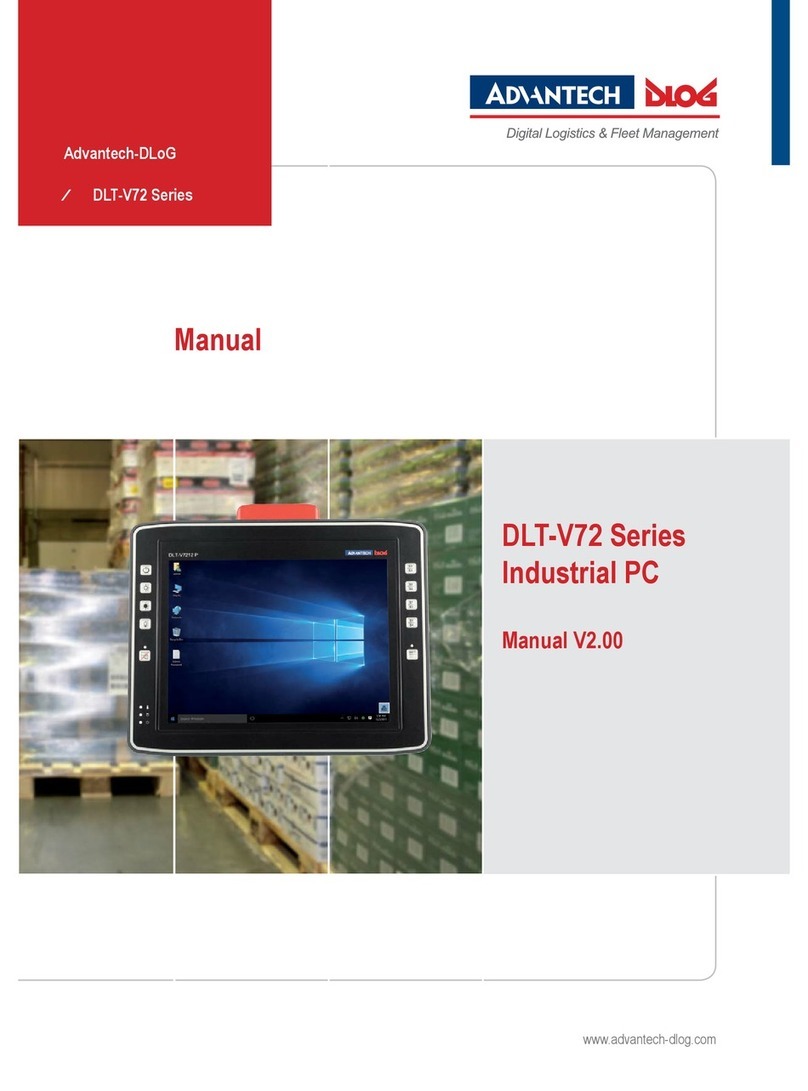
Advantech-DLoG
Advantech-DLoG DLT-V72 Series User manual
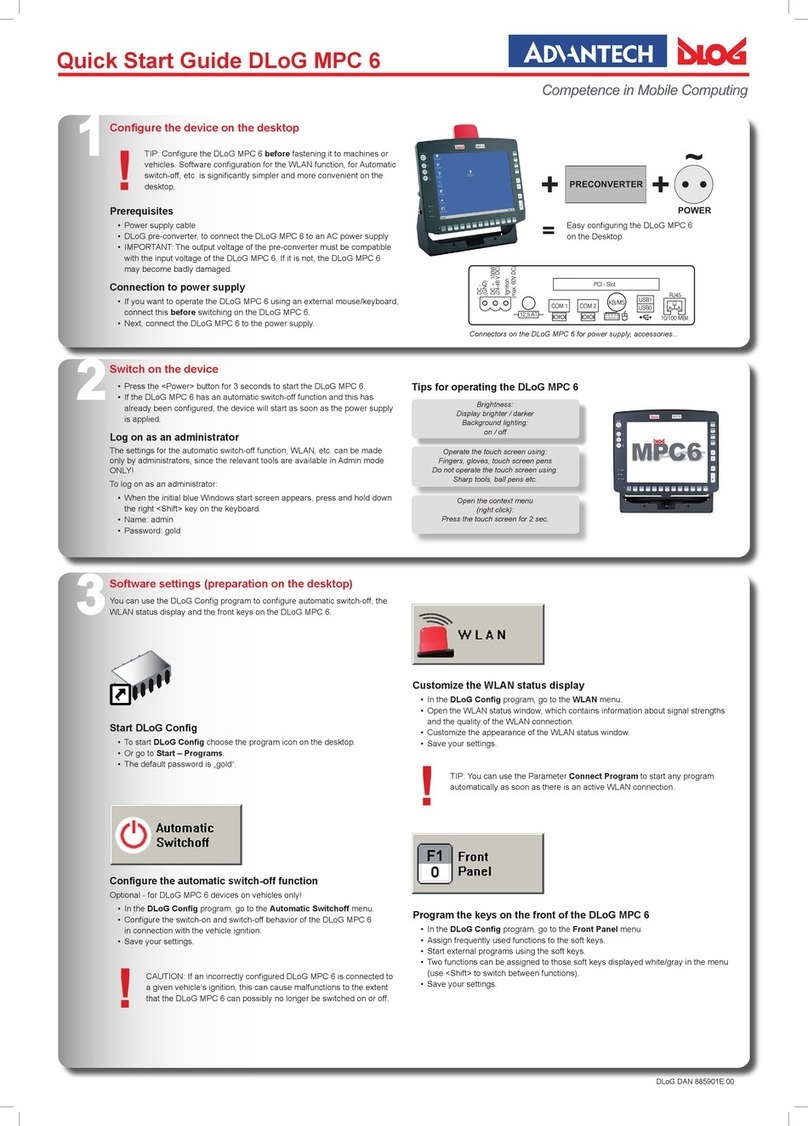
Advantech-DLoG
Advantech-DLoG MPC 6 User manual

Advantech-DLoG
Advantech-DLoG DLT-V6210 Installation instructions

Advantech-DLoG
Advantech-DLoG DLT-V4108 User manual
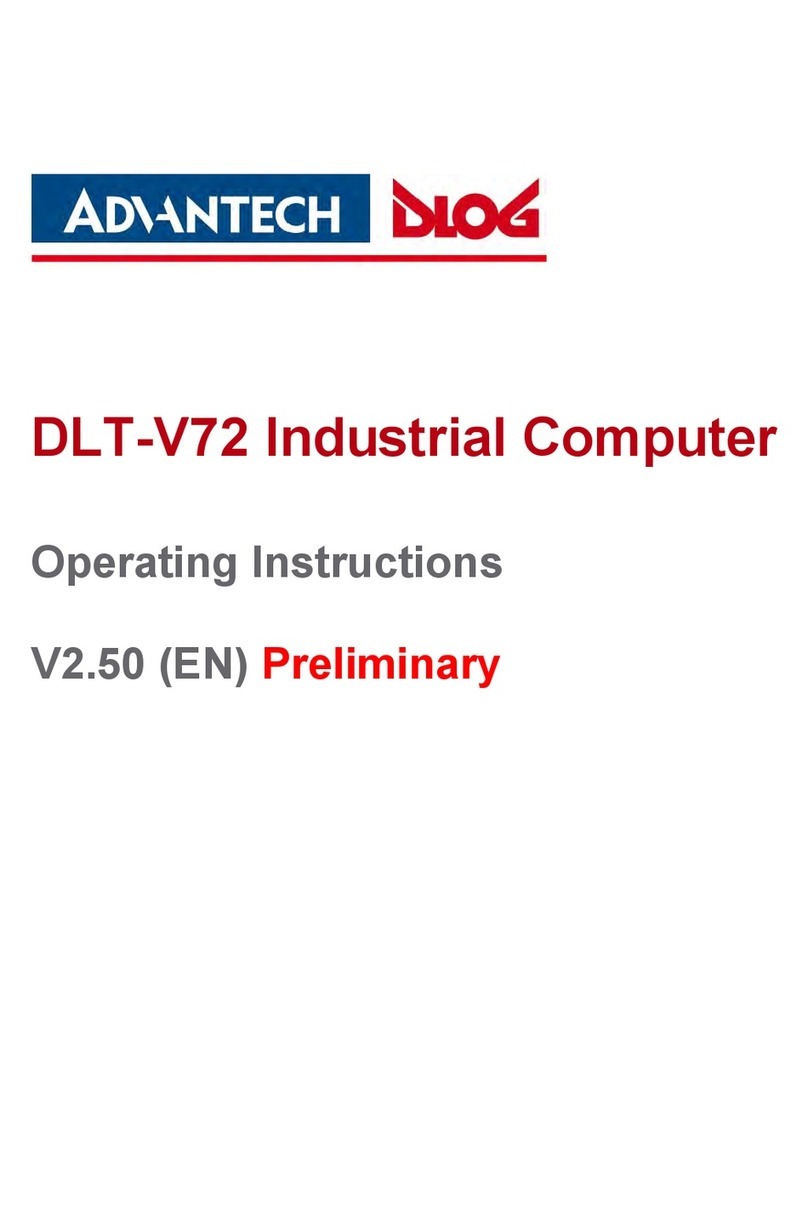
Advantech-DLoG
Advantech-DLoG DLTV72INT User manual

Advantech-DLoG
Advantech-DLoG DLT-V72 Series User manual

Advantech-DLoG
Advantech-DLoG DLT-V6210FL User manual
